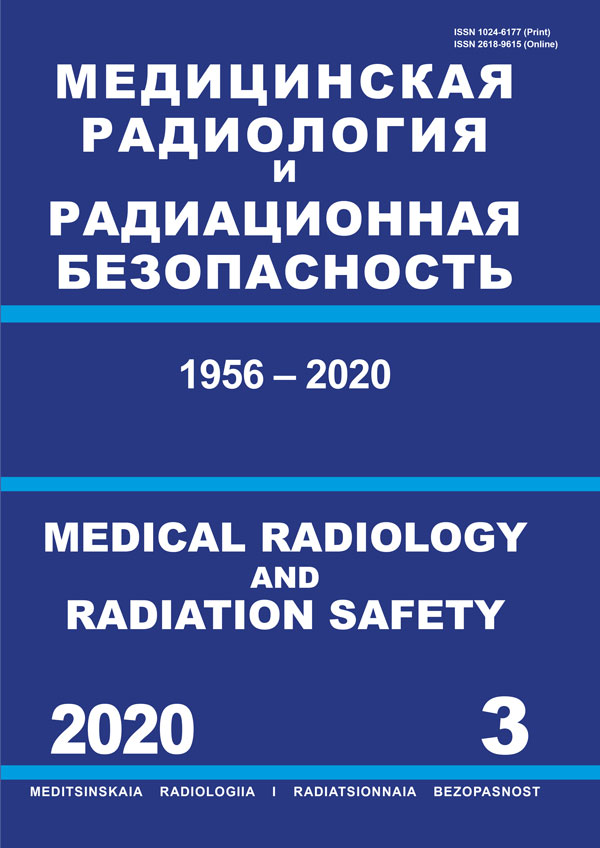Association of Medical Physicists of Russia (President)
Russian Federation
Moscow, Russian Federation
Purpose: Development and clinical testing of methodology dosimetry planning of radionuclide therapy based on Monte Carlo simulation of radiation transfer process. Material and methods: The method of determination in absolute units of radiopharmaceutical (RP) activity accumulated in tumor lesions. The technique is based on scintigraphy syringe containing diagnostic RP activity, biplane patient scintigraphy after injection of the RP and determination of the RP accumulation when administered calculated using the Monte Carlo method for the absorption and scattering of radiation in the patient’s body and in the collimator of the gamma camera. Code MCNP Monte Carlo simulation was used. The layout of determination of the value of accumulated RP activity in the patient’s tumor site implies successive implementation of the following three steps. 1. Scintigraphic images are obtained of the vial containing already known activity of the RP placed at the fixed source-to-collimator distance, following which estimation of the detector count rate within the specified region of interest of the vial image is undertaken. 2. Therapeutic activity A0 is introduced in the patient’s body, scintigraphic examination of the patient is performed. Estimation of the detector count rate in the region where the tumor is located and the value of tissue background in the close enough vicinity to the tumor is performed using the tools for contouring the region of interest on the obtained planar image provided using the software imbedded in the scintigraphic equipment. 3. Value of accumulated activity RP in the affected tumor is determined according to the correction factor which is calculated using Monte-Carlo method for specific clinical case for the geometry used in obtaining scintigraphic images which is identical to the conditions of measurement of activity in the vial and in the patient’s body. The technique has been tested in the study, with an injection of 30 MBq of 123I-MIBG child with neuroblastoma. Results: The level of accumulation of radiopharmaceutical in the tumor of the adrenal gland was 0.78 MBq, i.e. 2.6 % of the administered activity. This corresponds to literature data (average about 2.4 %) for scintigraphic studies of children with neuroblastomas. When using the known calculation method for analytical formula without the introduction of corrections for the absorption and scattering of radiation was obtained a result of 1.02 MBq, i.e. overestimation was 31 %. Conclusions: Introduction calculated by the Monte Carlo method for the absorption and scattering of radiation during scintigraphy patient can improve the accuracy of dosimetry planning of radionuclide therapy.
radionuclide therapy, dosimetry planning, tumor foci, radiopharmaceutical accumulation, activity determination, Monte-Carlo method
Потребность в оценке ожидаемого терапевтического эффекта контроля над опухолью при дозиметрическом планировании радионуклидной терапии (РНТ) диктует необходимость повышения точности определения поглощенных доз в опухолевых очагах. Однако применение в РНТ источников внутреннего облучения в виде терапевтических радиофармпрепаратов (РФП) накладывает особый отпечаток на методики осуществления дозиметрического контроля поглощенных доз. Кроме того, значительная вариабельность показателей накопления РФП в патологических очагах и в нормальных тканях организма пациента, связанная с индивидуальными особенностями кинетики и динамики РФП, является неоспоримым доказательством необходимости проведения как индивидуального дозиметрического планирования процедуры РНТ, так и контроля очаговых доз после проведения курса РНТ. Обе эти задачи требуют обязательного определения абсолютной величины накопленной активности РФП в патологических очагах.
1. Kost S.D., Dewaraja Y.K., Abramson R.G., Stabin M.G. A voxel-based dosimetry method for targeted radionuclide therapy using Geant4 // Cancer Biother. Radiopharm., 2015. Vol. 30. No 1. P. 1-11.
2. Song N., He B., Wahl R.L., Frey E.C. EQPlanar: a maximum-likelihood method for accurate organ activity estimation from whole body planar projections // Phys. Med. Biol. 2011. Vol. 56. No 17. P. 5503-5524.
3. Siegel J.A., Thomas S.R., Stubbs J.B. et al. MIRD Pamphlet No. 16: Techniques for Quantitative Radiopharmaceutical Biodistribution Data Acquisition and Analysis for Use in Human Radiation Dose Estimates // J. Nucl. Med. 1999. Vol. 40. P. 37-61.
4. Plyku D., Loeb D.M., Prideaux A.R. et al. Strengths and weaknesses of planar whole-body method of 153Sm dosimetry for patients with metastatic osteosarcoma and comparison with three-dimensional dosimetry // Cancer Biother. Radiopharm. 2015. Vol. 30. No 9. P. 369-379.
5. Quantitative Nuclear Medicine Imaging: Concepts, Requirements and Methods. - Vienna: International Atomic Energy Agency. 2014.
6. Eckerman K.F., Cristy M., Ryman J.C. The ORNL mathematical phantom series. 1998.
7. Krstic D., Nikezic D. Input files with ORNL - mathematical phantoms of the human body for MCNP-4B // Computer Phys. Commun. 2007. Vol. 176. P. 33-37.
8. ICRP. Basic Anatomical and Physiological Data for Use in Radiological Protection Reference Values. ICRP Publication 89 //Ann. ICRP. 2002. Vol. 32. No 3-4.
9. Lyisak Yu.V., Demin V.M., Klimanov V.A. i soavt. Podhod k dozimetricheskomu planirovaniyu radionuklidnoy terapii // Izvestiya VUZov. Yadernaya energetika. 2016. No 3. S. 163-172.
10. Briesmeister J.F. MCNP - A General Monte Carlo N-Particle Transport Code. Version 4C. - LA-13709-M. 2000. 823 pp.
11. Schmidt M., Simon T., Hero B et al. The prognostic impact of functional imaging with 123I-MIBG in patients with stage 4 neuroblastoma.1 year of age on a high-risk treatment protocol: results of the German Neuroblastoma Trial NB97 // Eur. J. Cancer. 2008. Vol. 44. P. 1552-1558.
12. Howman-Giles R., Shaw P.J., Uren R.F., Chung D.K. Neuroblastoma and other neuroendocrine tumors // Semin. Nucl. Med. 2007.Vol. 37. P. 286-302.
13. Kushner B.H. Neuroblastoma: a disease requiring a multitude of imaging studies // J. Nucl. Med. 2004. Vol. 45. P.1172-1188.
14. Kushner B.H., Kramer K., Modak S., Cheung N.K. Sensitivity of surveillance studies for detecting asymptomatic and unsuspected relapse of high-risk neuroblastoma // J. Clin. Oncol. 2009. Vol. 27. P. 1041-1046.
15. Vik T.A., Pfluger T., Kadota R. et al. 123I-MIBG scintigraphy in patients with known or suspected neuroblastoma: results from a prospective multicenter trial // Pediatr. Blood Cancer. 2009. Vol. 52. P. 784-790.
16. Papathanasiou N.D., Gaze M.N., Sullivan K. et al. 18F-FDG PET/CT and 123I-metaiodobenzylguanidine imaging in high-risk neuroblastoma: diagnostic comparison and survival analysis // J. Nucl. Med. 2011. Vol. 52. No 4. P. 519-525.





